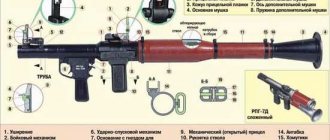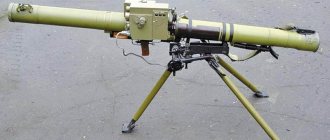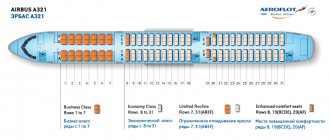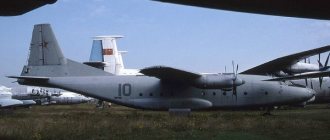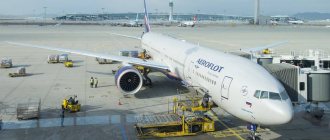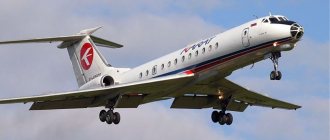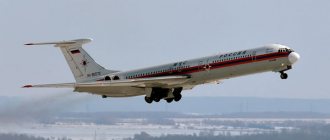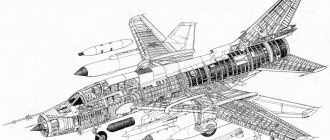Characteristics of the Il-16 attack aircraft
In fact, in terms of its characteristics, the Il-16 aircraft is similar to its “big brother” - the Il-10 attack aircraft. However, there are certain differences in aircraft designs.
Thus, the Il-16 is smaller in size compared to the Il-10, as well as lighter in weight, which, coupled with the improved strength of the fuselage, made it possible to perform aerobatic maneuvers on the aircraft. The maximum speed of the aircraft is 576 km/h, although, according to the original plans of the designers, this figure should have been about 625 km/h.
Characteristics of the Il-16 attack aircraft:
- Wingspan, m – 12.5
- Length, m – 10.7
- Height, m – 3.6
- Wing area, m2 – 24
- Weight, kg: empty aircraft – 4315
- normal takeoff – 5780
- nominal – 1 x 2000
- near the ground – 529
- two 23-mm VYA-23 or NS-23 cannons (mounted on the wing) and a 12.7 UBS machine gun at the rear
General information
description?
Performance characteristics The first flight was carried out at the end of February 1975. The machine has been in intensive use since 1981; aircraft were involved in all armed conflicts on the territory of the former USSR, and not only. The latest episode of use was the war in Ossetia in 2008. Today it is known that attack aircraft of this series will be in service with our army at least until 2020, but - subject to the availability of modern modifications and the State order for the continuation of their production - this period is clearly postponed indefinitely. At the moment, Russia has about 200 SU-25. The technical characteristics of vehicles on combat duty are maintained through their constant modernization to modern realities.
General description of the Su-39 aircraft
Modifications compared to the initial Su-25 aircraft affected almost all systems and assemblies. The new vehicle was equipped with an aiming system called “Spear-25”, which operates on the principle of radar. This equipment operates in three-centimeter mode, which gives the machine significantly more functions. But the most important thing is that it can carry out combat missions, regardless of the time of day or weather conditions.
The first model of the Su-39 type aircraft was presented only in 1995 in the city of Zhukovsky. But only four years after this, this device was equipped with military weapons and a complete control system. The aircraft began state tests in 1997.
Aircraft survivability and stealth
The special paint allows the vehicle to remain inconspicuous over the battlefield, and the material from which the body is made allows it to absorb radio waves, making it virtually invisible.
Even when launching a rocket that the pilot could not see, a system called "Cargo Cargo" is triggered, which produces optical and electrical interference. A special cesium lamp, which has a power of 6 thousand watts, creates interference for missile retraction. In addition, the aircraft has standard safety systems, such as the release of thermal missiles, which deflect enemy thermal missiles.
To overcome enemy air defenses, the aircraft is equipped with an electronic warfare system. It is based on a reconnaissance radio station of the SRTR type, which can track all radars. This system can be programmed to search for more specific targets. All information about targets is displayed in the pilot's cockpit, indicating the direction and distance to the object. The aircraft also has a new installation of the “Gordeniya” type, which creates interference in the form of noise, flickering and at the same time redirects enemy missiles to the ground.
Main design features
The design was carried out using a well-proven normal aerodynamic design with a high location of the main wing. Unlike fighters, due to this solution, the attack aircraft receives the maximum degree of maneuverability at subsonic speeds.
For a long time, experts struggled with the optimal aerodynamic configuration of the vehicle, but the efforts spent did not go in vain: there are high lift coefficients in all types of combat maneuvers, excellent flight aerodynamics, and excellent maneuverability when approaching ground targets. Due to the special aerodynamics of the SU-25, the technical characteristics of which are discussed in the article, it has the ability to launch an attack at critical angles, while maintaining high flight safety. In addition, the aircraft can dive at speeds of up to 700 km/h, while tilting up to 30 degrees.
Story
In January 1986, by decision of the military-industrial commission under the Council of Ministers of the USSR, work began on an all-weather modification of the Su-25T, capable of operating at any time of day, which received the designation Su-25TM (factory designation T8TM). The new vehicle was to be equipped with new avionics and an expanded range of weapons. The vehicle being developed was required to reliably overcome enemy air defenses and effectively use weapons in the target area. And also the ability to fly at low altitude while skirting the terrain.
In the early 1990s, two Su-25T airframes: T8M-1 and T8M-4 were converted into T8TM-1 and T8TM-2, respectively. The first flight on the experimental T8TM-1 aircraft was made on February 4, 1991 by Sukhoi Design Bureau test pilot Anatoly Aleksandrovich Ivanov.
Production of the Su-25TM was planned to be organized at an aircraft plant in Tbilisi, where by that time the modernized Su-25T attack aircraft were being produced. However, these plans were not destined to come to fruition. The collapse of the USSR and the subsequent independence of Georgia put an end to the production of both the Su-25T and its modernized version, the Su-25TM. The USSR collapsed. And along with it all the cooperation that existed at that time for the production of these aircraft. Russia’s attempt to create an interstate organization (NPK “Sukhoi Attack Aircraft”), which for some time included an aircraft plant in Tbilisi, was not successful.
Therefore, Russia decided to transfer the production of the Su-25TM to the Ulan-Ude Aviation Plant, which at that time was producing the Su-25UB combat trainer and the Su-25UTG carrier-based trainer.
In 1993, at the aviation plant in Ulan-Ude, preparations began for mass production of T8TM (Su-25TM) aircraft. Using the remaining production backlog from the Su-25UB, the plant produced the pre-production T8TM-3 aircraft, which made its first flight on August 15, 1995. From the same year, the vehicle received a new official name - Su-39. However, the financial crisis and cuts in defense spending did not allow the production of serial vehicles to begin.
In 1995, the Aviaavtomatika Design Bureau began developing a weapon control system, which received the designation SUO-39P. Flight testing of new equipment at the GLITs MO began on October 21, 1998 (T8TM-4 machine, first flight March 25, 1998).
The Su-39 was never mass produced and never entered service with the Russian Air Force.
There was a project to upgrade the Su-25T to the Su-25TM (Su-39). However, almost all Su-25Ts that were in the Russian Air Force have been written off or are in non-flyable condition.
WINGED UNIVERSAL SU-25TM
The interaction of aviation and ground forces is one of the conditions for the successful conduct of modern combat operations. The forms of this interaction are determined by the adopted military doctrine. The local wars of the 1960s dealt a serious blow to the positions of supporters of the nuclear missile strategy, who considered front-line aviation as a means of delivering nuclear weapons. The Vietnamese and Arab-Israeli wars revealed the need to significantly increase the combat survivability and effectiveness of tactical aircraft with conventional weapons in conditions of intense fire resistance from enemy air defenses. These problems were partially solved by modifying and equipping the existing fleet of aircraft with tactical air-to-surface guided missiles.
Only a specialized battlefield aircraft—an attack aircraft—could radically solve these problems. In the spring of 1968, an initiative group at the Sukhoi Design Bureau began creating such a machine. The OKB's previous experience in creating fighter-bombers of the Su-7B and Su-17 family allowed us to evaluate the advantages and disadvantages of machines of this class and formulate the concept of a promising attack aircraft. During the acquaintance of the USSR Minister of Defense A.A. Grechko and the Air Force Commander P.S. Kutakhov in the fall of 1975 with the prototype of the Su-25 attack aircraft, they assigned the OKB the task of destroying tanks on the battlefield using missiles. The guidance systems of guided missiles created at that time for fighter-bomber aircraft did not provide a direct hit on the target in most launches. The defeat of the main scoring targets was counted when the rocket was detonated within a radius of 5-7 m from the aiming point. The same accuracy was ensured by the X-25 missile with a laser guidance system, which was part of the attack aircraft’s ammunition. True, test pilot of the Air Force Research Institute E.M. Kolkov on a Su-17, during tests of the Kh-23 missile with a radio command guidance system for a spore, pushed apart two trucks placed side by side with the explosion of the missile warhead in the first pass, and in the next two, destroyed them with a direct hit by missiles. But during the tests, shooting was carried out in good weather at a stationary and clearly visible target; in a real combat situation this task became much more complicated. In addition, there are not many pilots of such high qualifications in the Air Force, and the guidance system should have provided such capabilities to the average pilot.
Considering the importance of the task at hand, the P.O. Sukhoi Design Bureau began working on the deployment of the Shturm-V helicopter anti-tank missile system (ATGM) on the Su-25 and the creation of an aviation ATGM on its basis. Providing the ability to pilot the aircraft at any time of the day at low and extremely low altitudes and at the same time the need for a direct ATGM hit on a moving armored target determined the choice of a two-seat configuration: a pilot and an operator, like the Mi-24V combat helicopter with an ATGM with a radio command guidance system. In this situation, the choice of the Su-25UB twin, which was at the preliminary design stage, was also logical in this situation. This approach to the development of a new modification ensured 85-90% continuity in the airframe and aircraft systems with the Su-25UB.
Subsequently, preference was given to the promising Vikhr ATGM with a laser beam guidance system, developed for the Ka-50 helicopter. The Whirlwind ATGM made it possible to attack targets without entering their air defense zone. The high degree of automation of the guidance processes of the new ATGM was designed for its use by a pilot who was simultaneously piloting a winged vehicle. A single-seat aircraft with the Shkval sighting system, developed under the factory code T-8M.
Since the summer of 1976, work on an anti-tank modification of the attack aircraft was supported by a decision of the Military-Industrial Commission under the Council of Ministers of the USSR. After coordination and approval of tactical and technical requirements, the new attack aircraft received the official name Su-25T.
Detailed design of the Su-25T was completed in 1982. The following year, the P.O. Sukhoi Machine-Building Plant began building the first prototype of a modernized attack aircraft. To speed up the process, the OKB management made a decision, supported by an order from the Ministry of Aviation Industry, to build the Su-25T using the first Su-25UB prototype airframe that was being assembled.
In June 1984, the construction of the Su-25T prototype was completed and it was transported to the OKB flight test station at the M.M. Gromov Flight Research Institute. On August 17, test pilot A.N. Isakov took the modernized attack aircraft into the air for the first time. In 1985 and 1986 The second and third prototypes were connected to the tests. Due to the refinement of the sighting and aerobatic system with the Shkval daytime optical-electronic sighting system (OEPS) and the Whirlwind anti-tank missile system, the stage of flight testing was delayed so that its completion had to be combined with the first stage of state tests, which were successfully completed at the end of 1990 th.
The modernized Su-25T attack aircraft was planned to replace the production of the Su-25 during 1990 at the Tbilisi Aviation Production Association named after G.K. Dimitrov, where the design bureau transferred the design documentation in 1987. The serial plant in Tbilisi began manufacturing equipment for the head of the Su-25T fuselage, and at the end of the year the airframe of the first production aircraft was handed over for final assembly. In 1988, the plant already produced two Su-25T airframes. In 1989, final assembly of the first two production aircraft of this modification began in Tbilisi.
The first of them flew on July 26, 1990, by factory test pilot V.P. Korostiev. Until the summer of 1991, an initial batch of modernized attack aircraft was produced in Tbilisi, most of them were intended for continued testing.
The aircraft was first publicly demonstrated in November 1991 at an international exhibition in Dubai (United Arab Emirates), under the designation Su-25TK (anti-tank, commercial). At one time in 1993-1994. this modification of the aircraft was called the Su-34 Strike Shield.
To work effectively in a market economy, in November 1992, the chief designer of the aircraft, V.P. Babak, organized the Sukhoi Attack Aircraft Research and Production Concern. The concern included 46 enterprises related to the development, production and sale of the Su-25 attack aircraft.
The production of the Su-25T and its improved variants was organized at the Ulan-Udinsky Aviation Plant, which previously produced combat training modifications of the Su-25.
In 1993, state tests of the modernized Su-25T attack aircraft were successfully completed, and it entered service with the Russian Air Force.
During the development of the Su-25T, in January 1986, a decision was issued by the military-industrial complex under the Council of Ministers of the USSR on the development of an all-weather and round-the-clock modification of the Su-25T—Su-25TM.
For round-the-clock use of weapons by the new attack aircraft, the Krasnogorsk Mechanical Plant named after S.A. Zverev developed the I-251 sighting system with an improved Shkval-M OEPS. The complex provides recognition, automatic tracking of small and moving targets, issuance of target designation (TC) and automatic guidance of guided missiles, as well as control of the firing of rockets and cannon weapons.
To carry out airstrikes at night and in low light levels, the Mercury low-level television sighting system was included in the sighting system. Since the volume of the aircraft airframe is limited and there was not enough space for everything, the new system was created in a container version.
Round-the-clock availability and automation of the process of combat use, an expanded composition of modern controlled aviation high-precision weapons, on-board reconnaissance, target designation and electronic warfare means—it is these areas that have become priorities for the P.O. Sukhoi M3 in increasing the combat capabilities of the attack aircraft at the stage of its development. This was facilitated by the development at the OKB in 1989 of a preliminary design for the next supersonic fighter-bomber S-37. Despite the positive conclusions received, due to changed conditions in our country, the development of the project was stopped. And the scientific and technical groundwork was used to expand the range of tasks solved by the Su-25TM.
Adjustments were made to the original concept of a 24-hour attack aircraft with precision weapons. This was due to entry into the international market, where in peacetime a highly specialized combat aircraft, such as the Su-25T, was affordable only by the powerful Air Force, when the operation of a large and diverse aircraft fleet was economically justified. With limited funding and a stable regional political environment, it is more profitable to effectively modernize existing military equipment. The aircraft fleet is updated with the appearance on the aviation market of promising aircraft with a predictable future, with preference given to multifunctional aircraft capable of effectively solving most of the tasks defined by the national military doctrine. The multifunctional aircraft allows maintaining the required level of professional training of flight personnel, and combat effectiveness is ensured by modifications that take into account the characteristics of the theater of operations and planned modernization during operation. Taking these circumstances into account, in 1995 the Su-25TM attack aircraft was modernized, aimed at expanding its functionality. Its export version is known as the Su-39.
Su-25TM attack aircraft:
1—PVD rod; 2—front antenna of the state identification system “Password-2D”; 3—moving part of the flashlight; 4—antenna of automatic radio compass ARK-15M; 5—radiotransparent keel end—radome of the antenna of the R-862 meter and decimeter range radio station; 6—rudder; 7—optical-electronic jamming station “Dry Cargo”; 8—drogue parachute container; 9—antenna for HF radio station for communication with ground forces R-828; 10—footboard; 11—fixed gun mount NPPU-8M with a GSh-2-30 gun; 12—slip sensor vane; 13—aviation ejection device AKU-58-1; 14—anti-radar missile X-58E; 15—PU-0-25-L launch container with S-25L air-to-surface guided missile; 16—guided missile S-25L; 17—main air pressure receiver PVD-18; 18—antennas of the “Pion” antenna-feeder system; 19—five-section slat; 20—radiotransparent antenna radomes of the Irtysh electronic warfare complex; 21 — right side aeronautical light (green); 22—static electricity dischargers; 23—hatch cover for the filler neck of the wing fuel tank; 24—wheel KN-27 (680×260 mm); 25 - 800-liter external fuel tank; 26-1150 liter external fuel tank; 27—wheel KD-207 (680×260 mm); 28—left side of the cabin; 29—dashboard; 30—right side of the cabin; 31—left remote control; 32—right remote control; 33—emergency PVD-7; 34—porthole of the Shkval optical-electronic sighting system; 35—radiotransparent antenna panel of the Doppler velocity and drift angle meter DISS-7; 36—beam holder BDZ-25 (when using weapons and PTB weighing from 500 to 1000 kg, they are replaced at suspension points 3,4,5,7,8 and 9 with universal beam holders); 37—pylon-holder PD-62-8; 38—left side aeronautical light (green); 39—\\,-shaped brake flap; 40— landing and taxi headlight; 41 — container with a small-sized active radio interference station MPS410; 42—system for shooting heat traps UV-26; 43—container radar “Spear-25”; 44—container with the Mercury system; 45—container with the Hod-Dagger system; 46—anti-ship missile X-35; 47—incendiary tank ZB-360; 48— adjustable aerial bomb KAB-500Kr; 49—aviation launcher APU-60-1MD; 50—short-range air-to-air missile R-60M; 51 — aviation launcher APU-68UM2; 52—air-to-surface guided missile Kh-25ML; 53—universal pylon
During the modification process, the aircraft was equipped with a modern multifunctional radar sighting system (RLSK) "Spear-25" of a three-centimeter range and an improved OEPS "Shkval-M", which significantly increased the range of combat use of the Su-25TM and made it possible to speak of it as a multifunctional all-weather tactical aircraft . The Spear-25 RLPK was also placed in the ventral container.
In Ulan-Ude, using the existing production reserve for the Su-25UB, they were able to produce four prototypes of the experimental Su-25TM—that’s when, given the current economic situation, a high degree of unification of modifications of the Sukhoi Design Bureau attack aircraft came to the fore. The first Su-25TM assembled in Ulan-Ude was presented in August 1995 at MAKS-95 in Zhukovsky with a mock-up of the Spear-25 RLPK. Since mid-1997, on the second copy of the Su-25TM, the new missile weapons were linked to the new on-board weapon control system and flight tests of the Spear-25 RLPK began. It was joined by a third prototype in August.
Currently, the Su-25TM is in the final stage of testing, the completion of which has been delayed due to lack of funding.
Like the Su-25, its modification Su-25T was tested in real combat conditions during testing. In October 1999, 4 Su-25Ts landed at the airfield in Budenovsk for combat tests in Chechnya. During them, military pilots carried out about 20 combat missions, which had positive results. When flying in Chechnya, the main difficulty was detecting well-camouflaged targets, even when coordinating actions with army intelligence. Heavy cloud cover and persistent haze, mountainous terrain and limited guidance accuracy provided by the navigation system used by the Su-25 aircraft hampered precision bombing operations.
Under these conditions, the Shkval system, which has a television channel with a narrow field of view and 23x magnification, brought a lot of benefits. Pilots could detect, identify and capture targets from a distance of up to 20-22 km. KAB and UR were launched from a distance of 2-3 km and an altitude of 3-4 km.
In the fall of 1999, a Su-25T using a Kh-25ML missile destroyed an An-2, the last plane of Chechen militants at the airfield in Grozny, a space communications station, a repeater and other targets.
The accuracy of hitting a target, according to published data, when using the CAB was 1 m, and the UR was 0.5 m. During the tests, it became obvious that the aircraft needed to be equipped with a more accurate satellite navigation system and improved avionics capabilities, including the communication system.
In May 2000, the Ethiopian government used two Su-25TKs, recently purchased from Russia, against Eritrean separatists. During two combat missions, attack aircraft destroyed two Kvadrat air defense systems with Kh-25MP anti-radar missiles and Kh-29T television-guided missiles. According to other sources, the complexes were destroyed by S-24 missiles fired from a Su-25UB aircraft. In total, in May - June 2000, Su-25s carried out 8 combat missions in Ethiopia. This is due to the lack of worthy targets in the combat zone. The command of the Ethiopian Air Force highly appreciates the results of the combat use of Russian Su-25TK attack aircraft.
How does the multi-role Su-25TM differ from its battle-tested predecessor, the Su-25?
A set of measures was further developed to ensure an increase in the combat survivability of the aircraft, taking into account the increased flight time and the capabilities of modern air defense systems of the ground forces.
The pilot, as on the Su-25, is placed in a cabin welded from ABVT-20 aviation titanium armor, the total weight of which in the airframe design is reduced by 153 kg, or 25%. At the same time, the weight of polyurethane foam and the rapidly swelling outer protector of fuel tanks of increased capacity has increased by almost the same amount. Filling the compartments adjacent to the fuel tanks with elastic porous materials prevents the impulse splash of fuel through holes in the tank from shells and their fragments, preventing fire in the compartments. The gaps between the fuel tanks and the air intake channels virtually eliminate the possibility of a fire from fuel entering the engine inlet. The design of the central part of the fuselage, fuel system lines and control rods has been strengthened.
The combat survivability of the Su-25TM is ensured not only by the resistance of its design to damage from shells and fragments. Great importance is attached to reducing the visibility of the aircraft over the battlefield. To reduce it in the optical range, a special paint and radio-absorbing coating are applied to the aircraft to reduce the effective reflective surface when irradiated by the radar.
Portable anti-aircraft systems are used on attack aircraft mainly from the rear hemisphere. It is almost impossible for a pilot to detect the launch of small missiles with thermal homing heads (TGSN). The Sukhogruz optoelectronic jamming station installed at the base of the fin protects the aircraft from missiles with TGSN. A powerful 6-kW cesium lamp creates amplitude-modulated interference to TGSN coordinators, shaking the missile guidance circuit and disrupting interception. The traditional means of programmatic setting of false thermal targets has not been forgotten either. The UV26 ejection device contains 192 jamming cartridges.
Engine engineers also made their contribution to reducing the visibility of the Su-25TM. The engine nacelles were modified to accommodate the installation of a non-afterburning turbojet engine with an unregulated nozzle R-195 with a maximum thrust increased by 10% and with a thermal signature reduced several times. The thermal signature of the engine is reduced by installing an enlarged central body and profiling the flame tube, eliminating direct visibility of the turbine blades, as well as reducing the temperature of the exhaust gases by blowing atmospheric air through the annular gap. Cooling atmospheric air is supplied to it through the engine compartment from the air intake on the upper surface of the rear part of the engine nacelle.
An important component in increasing the combat survivability of aircraft is the use of electronic warfare (EW) systems. Skillful use of an electronic warfare system increases the likelihood of successfully overcoming modern enemy air defenses.
The basis of the information system of the Irtysh electronic warfare complex installed on the Su-25TM is the electronic reconnaissance station (SRTR), which provides detection and circular azimuthal direction finding of the radar in a sector of ±30° in elevation. The SRTR range 1.2-18 GHz covers almost all operating frequencies of existing fire detection and control radars. In preparation for departure, it is possible to reprogram the station with prioritization of the most dangerous radiation sources. Information about the aircraft's radar exposure is displayed on an indicator in the pilot's cockpit, indicating the direction of the radiation source that poses the greatest threat.
MAIN CHARACTERISTICS OF THE SU-25TM AIRCRAFT
Type and number of adopted engines……………………………………………………….2хР-195
Non-afterburning take-off thrust, kgf………………………………………………………………………………2×4500
Length with MIA rod, m………………………………………………………………………………………15.33
Wingspan with containers. m………………………………………………………………………………14.36
Parking height, m……………………………………………………………………………………………………………..5.20
Chassis base when parked, m…………………………………………………………………………………………………………3.58
Chassis track, m…………………………………………………………………………………………………………….2.50
Normal "flight weight, kg………………………………………………………………………………….16 870
Maximum take-off weight, kg………………………………………………………………………………21 500
Mass of fuel in internal fuel tanks, kg………………………………………………………3840
Maximum flight speed. km;h………………………………………………………………………………………..450
Maximum number M…………………………………………………………………………………………………………..0.82
Maximum flight altitude, m………………………………………………………………………………..10 000
Radius of action with a combat load of 2000 m. km:
near the ground………………………………………………………………………………………………………………400
at an altitude………………………………………………………………………………………………………….800
Range with a combat load of 1540 kg (2xX-31A + 2 x R-77) with 4 PTB-800
when flying at high altitude, km………………………………………………………………………………..800
Take-off speed, km/h…………………………………………………………………………………………………………..250
Landing speed, kph/h………………………………………………………………………………………….240
Run length with uncoated BNP, m………………………………………………………………………………….600-700
Runway length on an unpaved runway, m………………………………………………………………600-700
Maximum operational overload………………………………………………………………………………….6.5
Maximum combat load weight, kg……………………………………………………………………………….6000
Ferry range (2 PTB-1150 and 2 PTB-800), km……………………………………………………….2250
Having SRTR information, the pilot, depending on the assigned combat mission, can: bypass the affected area of the air defense system; strike the radar with anti-radar missiles; deliver active radio interference using the Gardenia station, or carry out programmatic shooting of aircraft decoys to ensure evasion of enemy missiles with radar homing heads (RGSN).
Two small-sized containers with the Gardenia station, placed under the wing, provide in the protection sectors of ±60° in azimuth and ±30° in elevation the creation of distracting, noise, flickering and retargeting interference to the underlying surface.
In the pressurized cockpit of the Su-25TM at high altitude, an excess pressure of 0.25 kgf/cm2 is automatically maintained. This makes it possible to improve the pilot’s working conditions and raise the maximum flight altitude to 10 km to increase the ferry range, combat radius and detection range of radar-contrast targets.
In order to destroy a given target, it is necessary to accurately enter the specified area, detect it and clearly classify it.
The aircraft's navigation complex includes equipment for the long-range navigation radio system (RSDN), which uses modulated signals from domestic ground stations of the Chaika system and international Loran-S stations, which provide global navigation for civil and military aviation. In this case, the accuracy of determining the coordinates of the aircraft using the RSDN increases significantly: from 0.5% of the distance traveled plus from 0.5 km to 100 m. Autonomous flight to the target is also possible using an inertial navigation system with radar correction. Equipping the aircraft with the A-735 satellite navigation equipment unit allows it to work with the Uragan, NAVSTAR or GLONASS systems and reduce coordinate determination errors to 15 m, regardless of the flight range.
To significantly reduce the psychophysical stress on the pilot, the process of performing a combat mission with the multifunctional Su-25TM aircraft is automated as much as possible. The SAU-8 automatic control system installed on the aircraft provides, in any meteorological conditions, day and night, high-precision automatic and director control when aiming at a target when flying along a programmed route through specified intermediate points (route change points), exit to the target detection area, repeated approach to the attacked target, return and approach to the programmed airfield up to an altitude of 50 m according to signals from the SUV-25T Voskhod weapons control system.
In the elongated and expanded forward part of the fuselage and in the compartment there is a Shkval-M OEPS, the television image from which is sent to a television indicator installed in the upper right part of the instrument panel. When approaching the expected location of the target at a distance of 10-12 km, the OEPS begins operation in scanning mode. The Shkval-M system has a field of view of 10° and provides a 23-fold magnification of the target image. Depending on the flight altitude, it scans a strip of terrain ranging from 500 m to 2 km wide. The survey of the space is carried out in the scanning mode with the sighting head. Having seen an image similar to a target on the indicator screen, the pilot can stop scanning by pressing the target lock button on the aircraft control stick. After recognizing the target, the pilot carries out precise target designation by placing a reticle on the target image and pressing the binding button again.
To deliver a strike, the pilot holds the combat button pressed until the ammunition is released when passing the calculated release point. The pilot observes the results of the rocket launch and cannon fire on the television display screen. If necessary, he can automatically re-enter the target and exit the attack.
The Shkval-M system allows you to recognize targets at ranges significantly exceeding visual ones. For example, a detached house is recognized at a distance of up to 15 km, and a tank is recognized at a distance of 8-10 km. The target detected and selected by the pilot is taken for automatic tracking with the image memorized by the television machine, which is part of the OEPS. During any spatial maneuvers of the target, the system keeps it tracked, while simultaneously accurately determining the range to it. This ensures a direct hit by guided missiles, and the accuracy of the use of unguided weapons, including free-falling bombs, increases several times.
OEPS provides detection of targets illuminated by ground-based aircraft controllers. Such an attack can be carried out automatically. This is especially necessary on the line of combat contact to eliminate the possibility of striking friendly troops and to increase the accuracy of the use of weapons.
The television low-level surveillance and sighting system "Mercury", developed by the Moscow Research Television Institute, provides detection and recognition of targets such as a tank at night, by the light of the moon, in its first quarter at a distance of up to 3 km. This is enough to use guided and unguided weapons. A large target such as a railway bridge can be recognized under these conditions at a range of up to 6-8 km. The system has a switchable field of view—40 min and 120 min. The operating principle of the system is based on electronic processing of the TV image to increase its contrast and brightness to values that ensure recognition of real objects on the screen.
Equipping the Su-25TM with the Spear-25 radar sighting system with a slot antenna array provided a number of significant advantages compared to the original aircraft.
The main advantages include ensuring all-weather flights: detection and preliminary control capabilities for all types of weapons used by the attack aircraft, as well as a mapping mode, significantly expanding the range of combat missions solved by the Su-25TM as a multi-role aircraft.
When operating in mapping mode, the pulse-Doppler radar provides a main beam beam width of 4.5°, which provides general orientation on the ground, allowing only large terrain elements to be distinguished: roads, rivers, etc. Digital signal processing, known as “Doppler beam narrowing,” narrows the radar beam by 10 times, and the quality of the radar map on the indicator becomes acceptable.
Further improvement of the resolution on the radar map is achieved by the method of synthesized antenna equipment. This method provides a narrowing of the main lobe of the original radiation pattern by 20, 45 and 90 times.
Using the method makes it possible to detect, under any weather conditions, a group of tanks on a forest road at a distance of up to 25 km, a railway bridge - up to 100 km, and a missile boat at sea - up to 75 km. After receiving a radar map on the indicator screen, the image can be “frozen”, and the radar radiation can be turned off for greater secrecy: the high-precision navigation system will provide access to the target area. In conditions of visual visibility, preliminary command control from the radar system of the Shkval-M complex significantly increases the likelihood of a successful attack on the first approach.
To effectively carry out its combat mission, the Su-25TM has an impressive arsenal, including cannon, bomb, unguided and guided missile weapons.
The creators of the Su-25TM replaced the built-in cannon mount VPU-17A with the NPPU-8M with the same 30-mm GSh-2-30 (A017A) cannon and 200 rounds of ammunition. At the same time, the installation “moved” from the pre-cabin compartment down, under the middle part of the fuselage, with a shift to the right relative to the axis of symmetry. This placement of the installation allowed us to solve several problems: to reduce the load on the sighting system equipment when firing, while ensuring rigid mounting of the installation in the strongest part of the airframe, and to reduce the influence of powder gases during firing on the stability of the engines. The attack aircraft's cannon armament can be reinforced by two removable mobile SPPU-687 cannon mounts with 30-mm GSh-1 -30 guns with 150 rounds of ammunition, suspended under the wing.
Tactical aviation precision weapons (HPE) are very expensive. According to calculations, the cost of carrying out a combat mission to disable a concrete runway at a tactical aviation airfield using guided bombs is 10-12 times higher than the cost of carrying it out using conventional weapons alone. The share of airborne weapons in the fighting in Chechnya did not exceed several percent of the total number of aircraft weapons used. The main reason for this is difficult weather conditions and the lack of high-tech equipment suitable for use in these conditions, as well as the lack of means in the troops that allow accurate target alignment and the transfer of this information for operational target designation.
The current Russian Air Force relies on the combined use of unguided and high-precision aircraft weapons, using high-precision ammunition only against the most important enemy targets. The Su-25TM ensures the destruction of important targets with several types of high-precision weapons.
Adjustable aerial bombs (CAB) are relatively inexpensive and the most effective types of modular high-precision weapons designed to destroy ground and surface targets. The modular design principle of 500-kg aerial bombs made it possible to use for them unified seekers (television and laser) and several warheads (warheads): penetrating, high-explosive, cluster and volumetric detonating.
500-kg KAB with a penetrating warhead: KAB-500Kr—with a television and KAB-500L—with a laser seeker are designed to destroy particularly strong stationary ground targets: bridges, control posts, fortifications, as well as missile launchers at the launch position, ships in port
KAB-500Kr with a correlation-type television guidance system, which ensures target acquisition at a range of up to 5-7 km and, unlike the similar American KAB AGM-62 Walleye, which aims only at optically contrasting targets, ensures the destruction of non-contrast, camouflaged targets, fixing the position a conventional point specified by the aiming mark, relative to contrasting landmarks in the field of view of the seeker. Once dropped from the carrier, the bomb is completely autonomous. The presence of a built-in microprocessor in the seeker ensures correlation processing of information coming from the gyro-stabilized television camera of the seeker. When the KAB-500Kr approaches a target, the video information is periodically automatically rewritten by the microprocessor, providing electronic image scaling. Such a seeker, using one lens with a constant focal length, provides guidance accuracy of less than 3 m. Effective combat use of the KAB-500Kr does not cause difficulties even for young pilots. The Russian Air Force has developed a number of tactical techniques that increase the effectiveness of hitting various targets and ensure round-the-clock use.
High-precision weapons with a semi-active laser guidance system are the most common and provide round-the-clock engagement of targets. Fifty percent of these aerial bombs fall in a circle with a radius of 4-6 m with the center at the aiming point. In this case, laser illumination of the target can be carried out by the weapon carrier, a special aircraft or a ground station. The Su-25TM provides the use of four types of such weapons: the already mentioned KAB-500L bomb, as well as three guided missiles: Kh-25ML, Kh-29L and S-25L.
Such traditional weapons of attack aircraft as unguided air-to-surface missiles of caliber from 57 to 266 mm and aerial bombs of caliber up to 500 kg in various versions with a total weight of up to 4 tons have also not been forgotten.
The destruction of small-sized, armored targets is the priority combat mission of the Su-25TM. The main means of solving it are supersonic (maximum flight speed 620 m/s) ATGM “Vikhr” with a laser beam guidance system, created by the Tula Instrument Design Bureau. Today, this guidance system is optimal in terms of combat effectiveness. Onboard ATGM guidance equipment based on this principle, and the missile as a whole, have a significantly lower cost than missiles with traditional semi-active laser seekers. The guidance station produces a coded control laser beam. This beam is recorded by a sensor in the tail of the Whirlwind rocket. On board, commands are automatically generated to deflect the rudders to adjust the rocket’s flight path. The pilot can adjust the position of the aiming mark with a joystick (a movable button on the aircraft control stick) if it slides off the target. The Vikhr anti-tank system is an effective high-precision weapon capable of hitting the most modern foreign tanks (armor penetration up to 1000 mm) at ranges from 500 m to 10 km: the probability of hitting a small moving target such as a tank with one missile is 0.8.
The Spear-25 RLPK ensures the use of tactical anti-ship missiles (ASM) by the aircraft, the supersonic Kh-31A with an active radar seeker and the subsonic Kh-35 combined guidance system (inertial + ARGSN). The Su-25TM aircraft can carry four such anti-ship missiles. A flight of attack aircraft poses a real threat to a tactical group of surface ships and can attack a Spruance-class destroyer with a displacement of 7,800 tons without entering the range of its air defense fire weapons.
The Su-25TM is no less dangerous in an air battle: the Spear-25 RLPK detects a fighter with an EPR of 5 m2 on a collision course at a distance of up to 57 km, on a catch-up course - up to 25 km, accompanies up to ten simultaneously and fires at up to two targets; and the RVV-AE all-aspect air-to-air missiles with a combined guidance system make it possible to conduct air combat at medium distances on equal terms with fighters armed with Sparrow and AMRAAM missiles. And in close air combat, the new attack aircraft is “not a gift” for the enemy: Russian R-73 missiles are considered the best in the world, and the Sukhogruz optical-electronic suppression station is an effective means of countering such common missiles as the Sidewinder. To destroy a Su-25TM with fire from a 20-mm Vulcan aircraft rapid-fire cannon requires at least thirty hits—this is not an easy task, especially at low altitudes, where its turning radius and turn time are shorter than those of existing fighters.
Having acquired new qualities as a multi-role aircraft, the Su-25TM retained its reputation as a highly effective attack aircraft. This is ensured by a wide range of weapons, a sophisticated on-board equipment complex with a high degree of automation, and ensuring high levels of combat survivability. The effectiveness of the modification of the aircraft was confirmed by the conclusions of the leading domestic research institutes of industry and the Ministry of Defense, which modeled the processes of the Su-25TM performing main combat missions.
N. SOIKO
We recommend reading
- UNSUCCESSFUL “SCOUTS” Having moved at the very beginning of the 20th century, following the rest of the main “naval players” to the construction of large armored cruisers, Britain found itself at some crossroads. Very numerous...
- MITSUBISHI A6M ZERO The number of these fighters, produced in eight versions by the Japanese industrial concern Mitsubishi since 1939, was about 10,499 (according to other sources - 10,937) copies...
Specifications
The technical characteristics of the Su-39 are based on four pre-production aircraft and the Su-25T modernization project. Accordingly, the flight and technical performance of the attack aircraft are presented based on the tests performed and the results obtained.
Dimensions, weight, length
In terms of size, the Su-39 has the following indicators:
- total length - 15.33 m;
- wingspan - 14.36 m;
- height - 5.2 m;
- wing area - 30.1 sq. m;
- sweep angle - 20°;
- chassis base - 3.58 m;
- chassis track - 2.5 m.
Flight data
The flight characteristics of the attack aircraft are represented by the following values:
- with a full combat load, the aircraft flies at a speed of 950 km/h;
- landing speed - 240 km/h;
- The runway length on the concrete and dirt runways is 550 and 600 m, respectively.
The permissible practical flight altitude is 10 thousand m. In combat use, the attack aircraft can gain altitude from 30 m to 7 km. The combat flight range at a permissible altitude is 900 km, and at the ground - 400 km. With an external fuel tank (PTB-800), these values increase to 1250 and 750 km, respectively. The ferry range with four additional tanks (2x1150 and 2x800 l) is 2500 km.
Fuel consumption
Compared to the Su-25, the installation of new engines made it possible to reduce fuel consumption to 0.89 kg/kgf per hour. For comparison, for the base model this figure was 1.28 kg/kgf. The air consumption of the Su-39 is 66 kg/s.
Combat use[edit]
In 1999, during a counter-terrorism operation in Chechnya, 4 Su-25T attack aircraft carried out targeted strikes. Then the attack aircraft made more than 20 combat missions. Both guided missiles and CABs were used with high efficiency. Deciphering the results and video recordings made it possible to record the hit accuracy of laser-guided missiles - 0.5 meters, and of TV-guided air bombs - 1 meter.
The first and perhaps the last buyer of the Su-25T was Ethiopia, which is at war with Eritrea. The supply contract was signed at the end of 1999, and the aircraft were delivered to the supplier in the early 2000s. This speed is due to the fact that they took ready-made attack aircraft from the Lipetsk center (the pilots were trained there) and quickly modified them at the 121st aircraft repair plant in Kubinka to the Su-25TK standard (the equipment was slightly changed). The aircraft performed very successfully in the war, often using Kh-25MP and Kh-29T guided missiles along with conventional ammunition.
“Super Rook” also showed excellent survivability, so on May 20, 2000, during a successful attack on the position of the “Kvadrat” air defense system, one of the attack aircraft survived a close missile explosion, but reached the base safely. As of 2002, Ethiopia was still operating two of its Su-25TKs.
Military weapons
The Su-39's military weapons are represented by the following systems:
- GSh-30-02 cannon with a caliber of 30 mm and ammunition capacity of 200 shells;
- guided air-to-air missiles - two each R-60 and R-73 (or R-27R/T, or R-77);
- guided air-to-ground missiles - 16 supersonic anti-tank missiles "Vikhr" or 4 Kh-25 and 2 Kh-29L/T (or Kh-58, or Kh-31, or Kh-35), or 8 S-25L;
- unguided missiles - 160 S-8 with 80 mm caliber or 40 S-13 with 122 mm caliber or 8 S-24 with 240 mm caliber (or S-25 with 266 mm).
In addition to missiles, the attack aircraft is armed with free-falling and adjustable bombs. This weaponry is represented by eight half-ton FAB-500, RBK-500 or their 250-kilogram equivalents. Alternatively, other ammunition may be used.
The attack aircraft is also armed with cannon containers. This weaponry is represented by four SPPU-22-1 with a double-barreled GSh-23 cannon (caliber - 23 mm) with 260 rounds. An alternative could be four SPPU-687 installations with a 30 mm GSh-301 cannon and 150 rounds of ammunition.
The difference in weapons is due to the experimental nature of the development, as well as the multi-tasking nature of the attack aircraft. Depending on the goals set, the aircraft’s equipment also changes. And the lack of mass production and certain standardization left the issue of arming the Su-39 open. Essentially, the systems that the aircraft could use are presented.
Design description[edit]
The design of the aircraft is similar to the Su-25UB (85% unification). The difference lies in the single-seat cockpit (the armored unit of the Su-25UB is retained), the pre-cabin compartment of increased length, which houses the equipment of the Shkval sighting system, and the fin of increased area.
The power plant consists of 2 R-195 turbojet engines (the engine nacelles have been modified accordingly). There are 2 additional fuel tanks installed in the cockpit compartment and the rear fuselage.
The VPU-17A cannon mount was replaced with the NNPU-8M, with the mount itself moved from the cockpit compartment to the middle part of the fuselage (the gun barrel was moved out of the fuselage contours). 2 removable mobile installations SPPU-687 with GSh-301 cannons (200 rounds of ammunition) can be suspended under the wing. The armament includes air-to-surface missiles with laser and television guidance systems, anti-location missiles, and Whirlwind anti-tank guided missiles (up to 16 units). The Irtysh electronic warfare equipment with the Sukhogruz IR jamming station is installed in the rear fuselage.
In total, TAGO managed to produce a pilot batch of Su-25T aircraft in the amount of 12 aircraft before the collapse of the USSR. According to a number of sources, only 8 of the 12 aircraft were received by Russia.
After the collapse of the USSR, production was transferred to Ulan-Ude (by 2003, 4 modernized Su-25TM aircraft were manufactured from the Su-25UB production reserve, 4 more were unfinished). Previously produced Su-25s are also being modernized there. The Su-25T and Su-25TM were not produced serially.
The number of such aircraft in the Russian Air Force is extremely limited: the Russian Air Force has about 6 Su-25T on its balance sheet (at the beginning of 2000, 2 aircraft were exported after pre-sale preparation). Currently, all Su-25Ts are permanently parked at the Lipetsk Aviation Center.
Characteristics of Su-39 aircraft systems
The pilot controls this machine in comfortable conditions, especially since a significant part of the work is performed by the aircraft’s automation. This allows you to fly more efficiently and achieve maximum mission performance. The positive psychological state of the pilot is also accompanied by the presence of a fully armored cabin that can withstand a hit from a projectile of up to 30 mm caliber.
The take-off characteristics of the aircraft are excellent, since the Su-39 can take off from unpaved airfields, which are 1200 meters long. In addition, the aircraft is capable of safe landing and takeoff at altitudes of 3 kilometers above sea level. The aircraft has a high level of safety due to the presence of armor that can protect both the pilot and all important components of the aircraft. Due to the fact that the plane has two engines, if one fails, it can continue to fly on the other working one.
The power plant of the machine is represented by turbojet engines of the R-195 type; they provide the aircraft with a thrust of 4500 kilograms. The achievement of these engines is their low visibility in the infrared spectrum. As for weapons, the aircraft can lift 4 tons of various weapons into the air, including bombs and missiles of various calibers.
If we compare the Su-39 and foreign analogues, we can safely say that the domestic aircraft is significantly superior to them in price and efficiency. A pilot with any qualification can learn to fly this unit. Another special feature of this machine is that it runs on diesel fuel.
Design features of the Su 25 aircraft
For the Su 25 "Rook" , the traditional aerodynamic design was well suited - it is a monoplane with a high wing and a single-fin tail. Two power plants are located at the interface between the wing and the body, the landing gear is tricycle, retractable into the fuselage.
Su 25
The main goal of the designer was the survivability of the aircraft, so the pilot was placed in a kind of titanium capsule with thick armored glass. Important units had reliable armor protection; a polyurethane filler protected the fuel tanks, which were also filled with inert gas as they were used up.
The experience of the war in Afghanistan showed that the R-95Sh engines are located too close to each other; a MANPADS shell, hitting one engine, destroyed the second one. The deficiency was eliminated by installing a 1.5 meter long armor partition between the power plants and equipping the fire extinguishing system with four spherical cylinders with freon.
After these modifications, MANPADS did not shoot down a single Su 25 , although a large number of attack aircraft were damaged. Later versions of the Su 25T and Su 25TM have a somewhat “humpbacked” appearance, which was given to them by a compartment located behind the pilot’s cabin, and the canopy frame was structurally strengthened. The CRT screen displays the TV image on the windshield; the rear view periscope was abandoned in the new cabs. The escape system is equipped with a K 36L ejection seat and provides ejection at zero speed and zero altitude.
Eight universal pylons of special strength are located under the wing, of which the inner and middle ones carry fuel drop tanks, others are intended for aerial bombs and missiles, including the X-29T. The two outer pylons are equipped with holders for air-to-air missiles. Another suspension unit is located along the axis of the fuselage; it is intended for containers with ATGM guidance systems and multifunctional radars.
Su 25 cabin
One cannot fail to mention the Su 25UTG , designed specifically for training carrier-based aviation pilots. This attack aircraft was tested on board the Admiral of the Fleet of the Soviet Union Kuznetsov aircraft carrier.
Since coastal airfields were designated as the permanent location for the carrier-based attack aircraft, folding wings were not needed.
Detection and destruction of a target by a Su-39 aircraft
In order for this vehicle to operate at any time of the day, it is equipped with an I-251 class sighting system, which allows it to recognize targets of different sizes, guide weapons and fire cannons.
In the nose of the aircraft there is a system called Shkval-M, which displays an image of the terrain under the aircraft on the screen in the cockpit. This equipment makes it possible to monitor terrain ten kilometers from the target, while covering an area up to two kilometers wide. Using this system, the pilot can track a missile salvo and, if necessary, can launch a second attack. This system is so high quality that it can recognize a tank at a distance of 10 kilometers, and a residential building at a distance of 15 kilometers.
The Su-39 aircraft is equipped with air controllers that are not visible to the enemy, but this system allows for accurate automatic salvoes to be fired at specified targets. And most importantly, this system does not allow damage to its own military units.
The Sukhoi Corporation actively cooperates on the international market, offering its high-quality products at market prices. Many countries around the world buy our attack aircraft for money or in exchange for their own products, which are lacking in our country.
The Su-39 aircraft has received high confidence among many foreign analogues. To confirm this, we can say that the Sukhoi aircraft plant in Ulan-Ude has many orders for the production of this aircraft.
Modifications
| Model name | Brief characteristics, differences. |
| T8-M1 | The first copy of the Su-25T was created by converting the unfinished T-8UB (assembly was completed in Tbilisi in 1984, the first flight was made on August 17, 1984, pilot - A. N. Isakov), 3 flight prototypes were built and 1 for statistical testing ( 1985-1986). |
| Su-25T | Serial. In total, about 20 of these machines were produced. |
| Su-25TK | Export. It differs in the composition of on-board equipment. |
| Su-25TM (T-8TM) | Modernized. It is distinguished by an improved Shkval-M sighting system, the presence of a Kopyo-25 fire control radar (in a hanging container), a long-range navigation radio system, and an A-735 satellite navigation system. The installation of a container with thermal imaging equipment is provided. Developed in 1986-1995. The first flight took place on August 15, 1995, piloted by test pilot of the Sukhoi Design Bureau O. G. Tsoi. Pre-production vehicles were produced in Ulan-Ude. Not mass-produced. |
